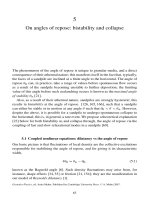On angles of repose - bistability and collapse
Bạn đang xem bản rút gọn của tài liệu. Xem và tải ngay bản đầy đủ của tài liệu tại đây (424.97 KB, 16 trang )
5
On angles of repose: bistability and collapse
The phenomenon of the angle of repose is unique to granular media, and a direct
consequence of their athermal nature; this manifests itself in the fact that, typically,
the faces of a sandpile are inclined at a finite angle to the horizontal. The angle of
repose θ
R
can, in practice, take a range of values before spontaneous flow occurs
as a result of the sandpile becoming unstable to further deposition; the limiting
value of this angle before such avalanching occurs is known as the maximal angle
of stability θ
m
[21].
Also, as a result of their athermal nature, sandpiles are strongly hysteretic; this
results in bistability at the angle of repose [126, 165, 166], such that a sandpile
can either be stable or in motion at any angle θ such that θ
R
<θ<θ
m
. However,
despite the above, it is possible for a sandpile to undergo spontaneous collapse to
the horizontal; this is, in general, a rare event. We propose a theoretical explanation
[23] below for both bistability at, and collapse through, the angle of repose via the
coupling of fast and slow relaxational modes in a sandpile [69].
5.1 Coupled nonlinear equations: dilatancy vs the angle of repose
Our basic picture is that fluctuations of local density are the collective excitations
responsible for stabilising the angle of repose, and for giving it its characteristic
width,
δθ
B
= θ
m
− θ
R
, (5.1)
known as the Bagnold angle [6]. Such density fluctuations may arise from, for
instance, shape effects [34, 35] or friction [21, 154]; they are the manifestation in
our model of Reynolds dilatancy [1].
Granular Physics, ed. Anita Mehta. Published by Cambridge University Press.
C
A. Mehta 2007.
63
64 On angles of repose: bistability and collapse
The dynamics of the angle of repose θ(t) and of the density fluctuations φ(t)
are described [23] by the following stochastic equations, which couple their time
derivatives
˙
θ and
˙
φ:
˙
θ =−aθ + bφ
2
+
1
η
1
(t), (5.2)
˙
φ =−cφ +
2
η
2
(t). (5.3)
The parameters a, b, c,
1
,
2
are phenomenological constants, while η
1
(t), η
2
(t)
are two independent white noises such that
η
i
(t)η
j
(t
)=2 δ
ij
δ(t − t
). (5.4)
The first terms in (5.2) and (5.3) suggest that neither the angle of repose nor
the dilatancy is allowed to be arbitrarily large for a stable system. The second term
in (5.2) affirms that dilatancy underlies the phenomenon of the angle of repose; in the
absence of noise, density fluctuations constitute this angle. The term proportional
to φ
2
is written on symmetry grounds, since the the magnitude (rather than the
sign) of density fluctuations should determine the width of the angle of repose.
The noise in (5.2) represents external vibration, while that in (5.3) embodies the
slow granular temperature, otherwise known as Edwards’ compactivity [15], being
related to purely density-driven effects. We note that these equations bear more than
a passing resemblance to those in the previous chapter on orientational statistics of
bridges: the underlying reason for this similarity is the idea [23, 33] that bridges
form by initially aligning themselves at the angle of repose in a sandpile.
Examining the above equations, we quickly distinguish two regimes. When the
material is weakly dilatant (c a), so that density fluctuations decay quickly to
zero (and hence can be neglected), the angle of repose θ (t) relaxes exponentially
fast to an equilibrium state, whose variance
θ
2
eq
=
2
1
a
(5.5)
is just the zero-dilatancy variance of θ. The opposite limit, where c a, and density
fluctuations are long-lived, will be our regime of interest here. When, additionally,
1
is small, the angle of repose has a slow dynamics reflective of the slowly evolving
density fluctuations. These conditions can be written more precisely as
γ 1, 1, (5.6)
in terms of two dimensionless parameters (see (5.13)):
γ =
c
a
,=
ac
2
2
1
b
2
4
2
=
θ
2
eq
θ
2
R
. (5.7)
The parameter γ , which sets the separation of the fast and slow timescales, is
an inverse measure of dilatancy in the granular medium; small values of this imply
5.2 How dilatancy ‘fattens’ the angle of repose 65
a granular medium that is ‘stiff’ to deformation, resulting from the persistence
of density fluctuations. The parameter measures the ratio of fluctuations about
the (zero-dilatancy) angle of repose to its full value in the presence of density
fluctuations: from this we can already infer that it is a measure of the ratio of
the external vibrations to density-driven effects, which are explicitly contained
in the ratio (
2
1
/
4
2
). Realising that external vibrations and density/compactivity
respectively drive fast and slow dynamical processes in a granular system,we
see that a quantity which measures their ratio has all the characteristics of an
effective temperature [69] in the slow dynamical regime of interest to us here.
This temperature-like aspect will become much more vivid subsequently, when we
discuss the issue of sandpile collapse.
To recapitulate: the regime (5.6) that we will discuss below is characterised as
low-temperature and strongly dilatant, governed as it is by the slow dynamics of
density fluctuations.
5.2 Bistability within δθ
B
: how dilatancy ‘fattens’ the angle of repose
Suppose that a sandpile is created in regime (5.6) with very large initial values for the
angle θ
0
and dilatancy φ
0
. In the initial transient stages, the noises have negligible
effect and the decay is governed by the deterministic parts of (5.2) and (5.3):
θ(t) = (θ
0
− θ
m
)e
−at
+ θ
m
e
−2ct
, (5.8)
φ(t) = φ
0
e
−ct
, (5.9)
with
θ
m
≈
b φ
2
0
a
. (5.10)
Thus, density fluctuations φ(t) relax exponentially, while the trajectory θ(t) has two
separate modes of relaxation. First, there is a fast (inertial) decay in θ (t) ≈ θ
0
e
−at
,
until θ (t) is of the order of θ
m
; this is followed by a slow (collective) decay in
θ(t) ≈ θ
m
e
−2ct
. When φ(t) and θ (t) are small enough [i.e., φ(t) ∼ φ
eq
and θ(t) ∼
θ
R
, cf. (5.11) and (5.13)] for the noises to have an appreciable effect, the above
analysis is no longer valid. The system then reaches the equilibrium state of the
full nonlinear stochastic process represented by (5.2) and (5.3), a full analytical
solution of which is presented in [23].
In order to get a feeling for the more qualitative features of the equilibrium state,
we note first that the equilibrium variance of φ(t) is:
φ
2
eq
=
2
2
c
. (5.11)
66 On angles of repose: bistability and collapse
We see next that, to a good approximation, the angle θ adapts instantaneously to
the dynamics of φ(t) in regime (5.6):
θ(t) ≈
b φ(t)
2
a
. (5.12)
The two above statements together imply that the distribution of the angle θ (t)is
approximately that of the square of a Gaussian variable. The typically observed
angle of repose θ
R
is the time-averaged value
θ
R
=θ
eq
=
b φ
2
eq
a
=
b
2
2
ac
. (5.13)
Equation (5.12) then reads
θ(t) ≈ θ
R
φ(t)
2
φ
2
eq
. (5.14)
Equation (5.14) entirely explains the physics behind the multivalued and history-
dependent nature of the angle of repose [70, 72]. Its instantaneous value depends
directly on the instantaneous value of the dilatancy; its maximal (stable) value θ
m
is
noise-independent [cf. (5.10)] and depends only on the maximal value of dilatancy
that a given material can sustain stably [21]. Sandpiles constructed above this will
first decay quickly to it; they will then decay more slowly to a ‘typical’ angle of
repose θ
R
. The ratio of these angles is given by
θ
m
θ
R
=
φ
2
0
φ
2
eq
, (5.15)
so that θ
m
θ
R
for φ
0
φ
eq
. Within the Bagnold angle δθ
B
(i.e. for sandpile incli-
nations which lie in the range θ
R
<θ<θ
m
), this simple theory also demonstrates
the presence of bistability. Thus, sandpiles submitted to low noise are stable in this
range of angles (at least for long times ∼ 1/c); on the other hand, sandpiles sub-
mitted to high noise (such that the effects of dilatancy become negligible in (5.2))
continue to decay rapidly in this range of angles, becoming nearly horizontal at
short times ∼ 1/a.
Our conclusions are that bistability at the angle of repose is a natural consequence
of applied noise (tilt [126, 165] or vibration) in granular systems. For sandpile
inclinations θ within the range δθ
B
, sandpile history is all-important: depending on
this, a sandpile can either be at rest or in motion at the same angle of repose.
5.3 When sandpiles collapse 67
5.3 When sandpiles collapse: rare events, activated processes and
the topology of rough landscapes
When sandpiles are subjected to low noise for a sufficiently long time, they can
collapse [69], such that the angle θ(t) vanishes. Such an event is expected to be
very rare in the regime (5.6); in fact it occurs only if the noise η
1
(t) in (5.2) is
sufficiently negative for sufficiently long to compensate for the strictly positive
term bφ
2
. It can be shown [23] that the equilibrium probability for θ to be negative,
= Prob(θ<0), scales throughout regime (5.6) as:
≈
(2)
1/4
(1/4)
F(ζ ),ζ=
γ
1/2
=
b
2
2
a
3/2
1
. (5.16)
The scaling function F(ζ ) decays [23] monotonically from F(0) = 1toF(∞) = 0;
to find out when the angle of repose first crosses zero, we should explore the latter
limit, i.e. the regime ζ 1. Here, the equilibrium probability of collapse vanishes
exponentially fast:
∼ exp
⎛
⎝
−
3
2
γ
2
1/3
⎞
⎠
. (5.17)
The above suggests that sandpile collapse is an activated process, with a competition
between ‘temperature’ and ‘barrier height’ γ
2
. Collapse events occur at Poissonian
times, with an exponentially large characteristic time given by an Arrhenius law:
τ ∼ 1/ ∼ exp
⎛
⎝
3
2
γ
2
1/3
⎞
⎠
. (5.18)
The stretched exponential with a fractional power of the usual ‘barrier-height-
to-temperature ratio’ γ
2
/ is suggestive of glassy dynamics [149, 150]; it also
reinforces the idea that sandpile collapse is a rare event.
While the reader is referred to a longer paper [23] for the derivation of the
stretched exponential, the physics behind it is readily understood by means of
an exact analogy with the problem of random trapping [167], which we outline
below.
Consider a Brownian particle in one dimension, diffusing (with diffusion constant
D) among a concentration c of Poissonian traps. Once a trap is reached, the particle
ceases to exist, so that its survival probability S(t) is also the probability that
it has not encountered a trap until time t. Assuming a uniform distribution of
starting points, the fall-off of this probability can be estimated by first computing the
probability of finding a large region of length L without traps, and then weighting
68 On angles of repose: bistability and collapse
this with the probability that a Brownian particle survives within it for a long
time t:
S(t) ∼
∞
0
exp
−cL −
π
2
Dt
L
2
dL . (5.19)
The first exponential factor exp(−cL) is the probability that a region of length L
is free of traps, whereas the second exponential factor is the asymptotic survival
probability of a Brownian particle in such a region, exp(−Dq
2
t). The integral is
dominated by a saddle-point at L ≈
2π
2
Dt
c
1/3
, whence we recover the well-
known estimate
S(t) ∼ exp
−
3
2
2π
2
c
2
Dt
1/3
. (5.20)
Notice the similarity in the forms of (5.17) and (5.20); it turns out that the steps
in their derivations are identical [23], and form the basis of an exact analogy. In
turn the analogy allows us to formulate an optimisation-based approach to sandpile
collapse, which makes for a much more intuitive grasp of its physics.
Accordingly, let us visualise the angle θ as an ‘exciton’ whose ‘energy levels’
are determined by the magnitude of θ . It diffuses with temperature in a frozen
landscape of φ (dilatancy) barriers of typical energy γ . Only if it succeeds in finding
an unusually low barrier can it escape via (5.17), to reach its ground state (θ = 0) –
this of course corresponds to sandpile collapse. Taking the analogy a step further,
we visualise the exciton as ‘flying’ at a ‘height’ θ, surrounded by φ-peaks of typical
‘height’ γ in a rough landscape. Flying too low would cause the θ exciton to hit
a φ barrier fast, while flying too high would cause the exciton to miss the odd
low barrier. It turns out [23] that flying at θ ∼
1/3
allows the exciton to escape
via (5.17) (cf. the arguments leading to L ∼ t
1/3
above). Translating back to the
scenario of sandpile angles, the above arguments imply the following: angles of
repose that are too low are unsustainable for any length of time, given dilatancy
effects, while angles that are too large will resist collapse. Thus optimal angles for
sandpile collapse are found to scale as θ ∼
1/3
; sandpiles with these inclinations
show a finite, if small, tendency to collapse via (5.17).
Clearly, the frequency of collapse will depend on the topology of the φ-landscape;
the form (5.17) was valid for a landscape with Gaussian roughness [23]. What if
the landscape is much rougher or smoother than this? To answer this question, we
look at two opposite extremes of non-Gaussianness.
First, let us assume that density fluctuations are peaked around zero; typical
barriers are low, and the φ-landscape is much flatter than Gaussian. The exciton’s
escape probability ought now to be greatly increased. This is in fact the case [23];









